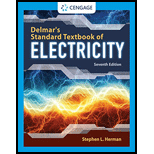
Delmar's Standard Textbook Of Electricity
7th Edition
ISBN: 9781337900348
Author: Stephen L. Herman
Publisher: Cengage Learning
expand_more
expand_more
format_list_bulleted
Concept explainers
Textbook Question
Chapter 11, Problem 13RQ
Name two factors that determine the speed an electron attains inside a gas environment.
Expert Solution & Answer
Want to see the full answer?
Check out a sample textbook solution
Students have asked these similar questions
I hope the solution is on paper and clear without the solution using artificial intelligence
A reflex klystron operates at the pcak of the n-2 mode. If (V1/Vo)-0.363, find the
efficiency. Assume β=1.
X"
1
1.2
1.52
2
2.408
Ji(X)
0.44
0.5
0.55
0.58
0.582
Solve question 1
Chapter 11 Solutions
Delmar's Standard Textbook Of Electricity
Ch. 11 - 1. Conduction in a liquid depends on the movement...Ch. 11 - What is a negative ion?Ch. 11 - 3. What is a positive ion?
Ch. 11 - Name three basic substances that can be used to...Ch. 11 - What is an electrolyte?Ch. 11 - 6. What is used to hold a sulfate ion together?
Ch. 11 - What is the negative terminal of a power source...Ch. 11 - Prob. 8RQCh. 11 - What determines the thickness of the coating...Ch. 11 - What is electrolysis?
Knowledge Booster
Learn more about
Need a deep-dive on the concept behind this application? Look no further. Learn more about this topic, electrical-engineering and related others by exploring similar questions and additional content below.Similar questions
- For the system below: if == m₁ =m₂ = 1 kg. k₁ = k₂ =1 Nm1, b = 20 N/ms"; then: 1) Find the transfer function () f(s) 2) Check the stability by Routh criteria method.arrow_forwardIf you have T.F.C.L.= k then: s2+2 5+k • 1) Find the open loop G(s). 2) Determine Steady state error for (unit step, ramp input, and acceleration input) 3) If es = 0.2, for ramp input, then find k,wn, 8. 4) For values in (3), then find t,,,,t, and M.. 5) For values in (4), then plot transient response with these values.arrow_forwardQ2) A. A three phase half wave controlled rectifier shown in fig (1) with a delay angle a, the input voltages are specified as va=100 cos(wt), v = 100 cos(wt + 120°), vc = 100cos (wt-120°) 1) Draw the average output voltage for a = 0°,30° and 60°. 2) Draw the la, land i, for each a 3) Calculate the average output voltage for each a n Va Vs Th, * Thz D Th3 R لے E Loadarrow_forward
- I hope the solution is on paper and not by artificial intelligencearrow_forwardObtain the number of roots in the RHP of D(s)=s+s+ 6s+5s3 + 10 s2 +58 +5arrow_forwardFor circuit below, if L = 0.5H, R=10,C=2, then 1) Find the transfer function Vo(s) u(s) of circuit below. 2) if u = k(v(t)- v,(t)), for feedback is added, find the value of k if peak overshoot is 0.2. 3) if u=(v(t)- v,(t)), for feedback is added, find the value of k if ess 0.2 for ramp input. - 4) if u = (1) ((t) vo(t)). Check the stability with varying the value of k for characteristic equation. R Votarrow_forward
- The question was sent hours ago and you sent an unclear answer. I hope the solution is on the paper and clear.arrow_forwardThe control system, shown in Fig. below, is subjected to a unit ramp function, a) Determine the value of k and k, such that the system has an overshoot of 16.303% and a damped natural frequency of 3.4641 rad/sec. b) Calculate the rise time, peak time and settling time. c) Define the system type d) Calculate the steady-state error of that system R(s) K (x+2) K ((s)arrow_forwardI hope the solution is on the paper and cleararrow_forward
- I hope the solution is on the paper and cleararrow_forwardPlease solve by pen and paper correctly step by step. Do not use chatgpt Or any AI tool.arrow_forwardConsider the circuit shown below, Vac 0- H Vdc ли R1 R2 where R₁ = 2.2KQ, R₂ = 4.7KQ, C = 0.1uF, Vdc = +5V, and Vac = 3V peak f = 1KHz. • Use superposition to calculate the DC voltage at point X; VDC = • Use superposition to calculate the AC (peak) voltage at point X; VAC =arrow_forward
arrow_back_ios
SEE MORE QUESTIONS
arrow_forward_ios
Recommended textbooks for you
 Delmar's Standard Textbook Of ElectricityElectrical EngineeringISBN:9781337900348Author:Stephen L. HermanPublisher:Cengage Learning
Delmar's Standard Textbook Of ElectricityElectrical EngineeringISBN:9781337900348Author:Stephen L. HermanPublisher:Cengage Learning Electricity for Refrigeration, Heating, and Air C...Mechanical EngineeringISBN:9781337399128Author:Russell E. SmithPublisher:Cengage Learning
Electricity for Refrigeration, Heating, and Air C...Mechanical EngineeringISBN:9781337399128Author:Russell E. SmithPublisher:Cengage Learning

Delmar's Standard Textbook Of Electricity
Electrical Engineering
ISBN:9781337900348
Author:Stephen L. Herman
Publisher:Cengage Learning

Electricity for Refrigeration, Heating, and Air C...
Mechanical Engineering
ISBN:9781337399128
Author:Russell E. Smith
Publisher:Cengage Learning
Introduction to Coulomb's Law or the Electric Force; Author: Flipping Physics;https://www.youtube.com/watch?v=4ubqby1Id4g;License: Standard YouTube License, CC-BY